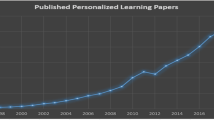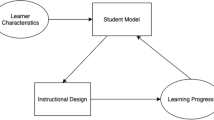Abstract
In order to effectively identify the pattern of personalized adaptive learning in online education and improve the recommendation satisfaction of personalized learning resources in online education platform, this paper studies the pattern recognition method of personalized adaptive learning in online education. The learning behavior pattern data in the online education platform are mined, preprocessed, clustered and made correlation analysis, and the obtained data are used to construct the learner’s personalized adaptive learning characteristics model; on this basis, the framework of learning pattern recognition model is constructed to recognize the personalized adaptive learning pattern from four aspects: cognitive level, learning style, interactive behavior pattern characteristics and online social learning characteristics. The experimental test results show that this method can effectively identify the personalized adaptive learning patterns of learners, including interactive learning behavior patterns and online social learning patterns. The personalized learning resources recommended by the online education platform according to the identification results of this paper have obtained the learners’ satisfaction score of a high level at 93.27%.







Similar content being viewed by others
References
Ritz H, Nassar MR, Frank MJ, Shenhav A (2018) A control theoretic model of adaptive learning in dynamic environments. J Cogn Neurosci 30(10):1405–1421
Pulukuri S, Abrams B (2020) Incorporating an online interactive video platform to optimize active learning and improve student accountability through educational videos. J Chem Educ 97(12):4505–4514
Klanja-Milievi A, Ivanovi M, Vesin B, Budimac Z (2018) Enhancing e-learning systems with personalized recommendation based on collaborative tagging techniques. Appl Intell 48(6):1519–1535
Díez J, Pérez-Núez P, Luaces O, Remeseiro B, Bahamonde A (2020) Towards explainable personalized recommendations by learning from users’ photos. Inf Sci 520:416–430
Zhou H (2018) Study on promoting Students’ personalized learning based on adaptive learning platform. E-Educ Res 039(004):122–128
Chen J, Fang H, Lin X, Zheng H, Yang D, Zhou X (2018) Personal learning recommendation based on online learning behavior analysis. Computer. Science 45(S2):432–436+462
Huang C, Zhu N, Huang Q, Han Z (2019) Behavioral big data visualization supporting personalized learning. Educ Res 25(2):55–66
Ciolacu M, Tehrani AF, Svasta PM, Binder L (2018) Education 4.0 - artificial intelligence assisted higher education: early recognition system with machine learning to support Students’ success[C]// IEEE. SIITME 3:25–28
Khan H, Asghar MU, Asghar MZ et al (2021) Fake review classification using supervised machine learning. Virtual Event 11(10):269–288
Mou ZJ, Zhang QN, Chen SR (2020) Learning behavior pattern recognition and teaching intervention based on behavior sequence. Mod Educ Technol 5:74–80
Liu S, Wang S, Liu X et al (2021) Fuzzy detection aided real-time and robust visual tracking under complex environments. IEEE Trans Fuzzy Syst 29(1):90–102
Tegunov D, Cramer P (2019) Real-time cryo-electron microscopy data preprocessing with warp. Nat Methods 16(11):1146–1152
Liu S, Liu D, Muhammad K et al (2021) Effective template update mechanism in visual tracking with background clutter. Neurocomputing 458:615–625
Ting L (2020) Clustering analysis of Mobile processor based on improved K-means algorithm. Adv Appl Math 09(11):2029–2035
Shuai L, Xinyu L, Shuai W et al (2021) Fuzzy-aided solution for out-of-view challenge in visual tracking under IoT assisted complex environment. Neural Comput Applic 33(4):1055–1065
Tiago O, Lúcio AD, de Souza VQ, Nardino M, Diel MI, Sari BG et al (2018) Confidence interval width for Pearson’s correlation coefficient: a Gaussian-independent estimator based on sample size and strength of association. Agron J 110(2):503
Biswas G, Rajendran R, Mohammed N, Goldberg BS, Sottilare R, Brawner KW et al (2020) Multilevel learner modeling in training environments for complex decision making. IEEE Trans Learn Technol 13(1):172–185
Nanda G, Douglas KA, Waller DR, Merzdorf HE, Goldwasser D (2021) Analyzing large collections of open-ended feedback from MOOC learners using LDA topic modeling and qualitative analysis. IEEE Trans Learn Technol 14(2):146–160
Shuai L, Shuai W, Xinyu L et al (2021) Human memory update strategy: a multi-layer template update mechanism for remote visual monitoring. IEEE Trans Multimedia 23:2188–2198
Peng G, Jingyi L, Shuai L (2021) An introduction to key Technology in Artificial Intelligence and big data driven e-learning and e-education. Mobile Netw Appl 26(5):2123–2126
Acknowledgements
The paper was funded by the Project on teaching reform of colleges and universities in Hunan Province with No. [2018]-436; Research project on curriculum ideological and political construction of colleges and universities in Hunan Province with No.HNKCSZ-2020-0474; the Research project on teaching reform of Hunan University of Arts and Sciences with No. JGZD1813; Natural Science Foundation of Hunan Province with No.2020JJ5368; the Industry-Academic Cooperation Foundation of the Ministry of Education of China with No. HKEDU-CK-20200413-129.
Author information
Authors and Affiliations
Corresponding author
Ethics declarations
Ethics approval
The authors have no relevant financial or non-financial interests to disclose. Peng Peng provided the algorithm and experimental results, wrote the manuscript, Weina Fu revised the paper, supervised and analyzed the experiment. We also declare that data availability and ethics approval is not applicable in this paper.
Additional information
Publisher’s note
Springer Nature remains neutral with regard to jurisdictional claims in published maps and institutional affiliations.
Rights and permissions
About this article
Cite this article
Peng, P., Fu, W. A Pattern Recognition Method of Personalized Adaptive Learning in Online Education. Mobile Netw Appl 27, 1186–1198 (2022). https://doi.org/10.1007/s11036-022-01942-6
Accepted:
Published:
Issue Date:
DOI: https://doi.org/10.1007/s11036-022-01942-6




